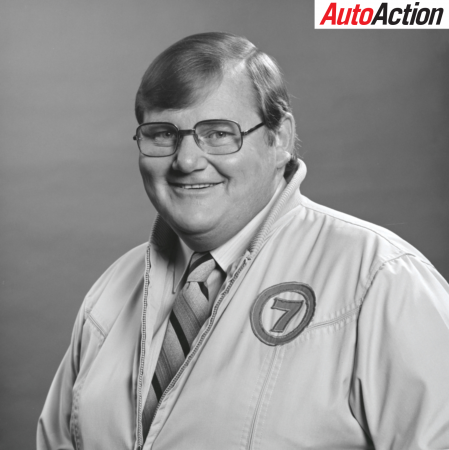MIKE RAYMOND CHANGED THE FACE OF RACING


Mike Raymond was the face of Channel Seven’s motor sport coverage. Image: Supplied
The way motor racing is presented and described on television is a lasting tribute to Mike Raymond.
By MARK FOGARTY
More than four decades ago, Raymond changed the way our sport is covered and called, and what we see and hear today is his legacy.
Broadcasts of Supercars and all levels of racing, as well as trackside commentary, are the way they are because of his original influence.
His promotional flair also established the template for innovative, personality driven TV coverage and his vision fostered technological advances that immerse viewers.
Raymond was one of the fathers of V8 touring car racing as we know it, laying the very foundations of Supercars.
Few people have had such a profound effect on racing in this country than Mike Raymond, who has been taken by pneumonia at age 76.
Tributes have flowed from the broadcasting and racing world – and rightly so.
A big man with a big heart for all forms of motor sport, Raymond revolutionised TV coverage of circuit racing and the promotion of speedway – his first love – in Australia.
His American approach to commentary and presentation wasn’t initially appreciated by dedicated enthusiasts when he joined Seven’s Bathurst 1000 coverage in the mid-1970s, who resented his hyperbolic, rapid-fire calls and initiatives to increase the razzmatazz of the event.
Fans were used to the sober, received accent delivery of the late Evan Green and his contemporary Will Hagon, and Raymond’s shouty, adjective-laden style grated.
His colourful commentary included classics like his description of Glenn Seton as “The baby faced assassin” and his promotional catchcry “Be there!”.
His influence grew in the 1980s, when he was director of sport at ATN7 in Sydney, which drove the nascent Seven Network’s coverage of the ATCC, Bathurst and Amaroo Park.

Raymond chatted to Foges about his distinguished career in the motor sport media. Image: Mark Fogarty
He was just as prominent in the rise of speedway in the mid-to-late 1970s as the inspired promoter at Liverpool City Raceway, the long defunct tarmac bowl that hosted some of the biggest names.
Among Raymond’s coups was bringing out American legends AJ Foyt and Johnny Rutherford for the Australian Speedcar Grand Prix at LCR.
He was also behind gaining international – and particularly American – recognition of the Bathurst 1000 by orchestrating overseas entries, including Rutherford and Janet Guthrie, and adding American racing broadcast legend Chris Economaki.
Raymond was the voice of Australian touring car racing until 1996, when he retired following a heart attack just before the onset of Supercars.
His impact was such that he deservedly gained induction to the Australian Motor Sport Hall Of Fame and the Bathurst Legends Lane.
A big part of his legacy is his mentorship – or at least inspiration – of Neil Crompton, Mark Oastler, Leigh Diffey and Greg Rust.
Crompton’s rise to the new voice of Supercars was, by his own admission, one of Raymond’s most satisfying achievements.
Perhaps his biggest contribution, though, was being a driving force of the change from international Group A to Holden versus Ford V8s in 1993.
That was the genesis of what became V8 Supercars in 1997. Ironically, Raymond clashed with Supercars founder Tony Cochrane, but they are inextricably linked in the development of V8 racing as it is today.
I first met Raymond as a young reporter in January, 1975 when I covered Foyt’s runaway speedcar AGP win at LCR.
In the following years, I didn’t always see eye-to-eye with him, but I admired his commitment and promotional panache.
His speedway influenced gift for revved-up promotion, which truly made the Liverpool banked oval “The Place Of Pace” into the early ’80s, was a model that is still applicable today.
In fact, his voiceover catchphrase “Be there!” has remained central to the advertising of venues like Avalon Raceway in Victoria and Sydney Speedway at Granville to this day.
His stature in the sport was such that I visited him in Sydney recently to talk about his long, distinguished and influential career.
He and his wife Carol were charming hosts, and Mike reminisced expansively about his heyday.
It was planned as a two-part ‘Up Front With Foges’ interview that was going to run at the end of this month and in early December.
I’m now of two minds. Would it be insensitive or a fitting tribute?
My gut instinct is the latter, if only because I know you’d be enraptured by his reminiscences and also his insightful thoughts on current racing.
Like any agent of change, Mike Raymond had his detractors back in the day. Too loud, too flashy, too in-yer-face in that XXXL red jacket.
But, in hindsight, he shaped the way we watch racing at home, as well as driving what became Australia’s premier, world-class touring car category.
For more of the latest motor sport news pick up the current issue of Auto Action. Also make sure you follow us on social media Facebook, Twitter, Instagram or our weekly email newsletter for all the latest updates between issues.






